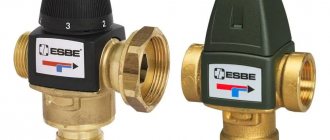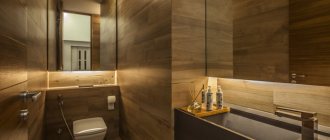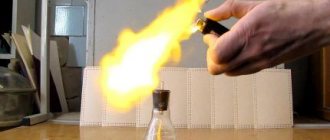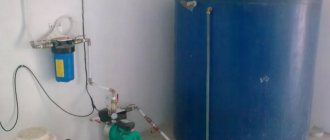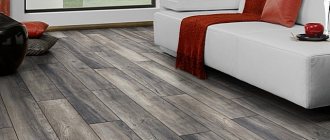The task of a standard air conditioning system is not to ensure the flow of fresh air into the room. However, it is not always possible to ventilate in the usual way - by opening a window or vent. In such a situation, an air conditioner with forced ventilation comes in handy. Let's look at what this equipment is, how it is designed and works, what its main advantages are, what types there are, and also what criteria to pay attention to when choosing.
Diagram of the design and operation of a supply air conditioner Source promklimat.ru
Air conditioner with inflow - what is it, device, principle of operation
A classic split system works exclusively to cool the air in the room. However, over several decades of using such technology indoors, several pressing problems have arisen:
- Large dimensions of the equipment. Because of this, their installation is often associated with associated troubles, for example, in the form of the use of specific installation where it is impossible to simply install bulky equipment. Modern models lack all this. They are light, small-sized and have an attractive appearance.
- The likelihood of the spread of pathogens with air currents. Microorganisms from the air can accumulate in the system and then spread throughout the interior. Modern devices have built-in modules for disinfecting incoming atmospheric flows, and therefore they are completely safe from this side.
- Lack of fresh air flow. According to the standards, about 30 cubic meters should be supplied per person in a room within an hour. meters of fresh air.
Modern duct-type air conditioner with fresh air supply Source sovet-ingenera.com
All these problems can be solved by installing a modern air conditioner with a forced-air ventilation function in a wall-mounted or duct version.
Device and principle of operation
The main difference between an air conditioning device with an air supply and a standard system is the presence of an air duct that takes in air from outside. Otherwise, its device is similar and has the following main parts:
- Evaporator equipped with a heat exchange circuit and a fan.
- Filter system.
- Electronic control unit.
- Outdoor module – including a compressor, cooler, condenser, turbine, mixing chamber.
In addition, the device can be equipped with a heater with an electric or water circuit to heat the incoming air during cold periods.
The operation of such an air conditioner in the supply ventilation mode obeys the following algorithm:
- Fresh air enters the evaporator unit through the air duct.
- Next, the mass of the outer atmosphere mixes with the inner one.
- After this, the flow passes through a sequential system of additional devices - heater/cooler, dehumidifier/humidifier, disinfectant, etc.
Passing through a perfect cleaning system, street air becomes sterile Source premium-landing.ru
- At the end, the finished stream enriched with fresh air enters the room.
On a note! Installing a supply air conditioner is especially important in conditions where it is not possible to ventilate the room naturally. For example, there is smoke, dust, gas, or just cold outside.
Static pressure chambers
The plenum is used in conjunction with vent grilles to reduce pressure, equalize airflow, and dampen noise. Cameras are very bulky, but without them it is useless to take on such a project.
I was imbued with respect for the Swedes - all the holes in the chambers and mufflers were covered with plastic “caps”. A few photos:
The black tube is a braided cable that moves the round perforated diffuser. The purpose of the diffuser is to regulate the flow, increasing or decreasing the resistance to the flow, and it is natural to disperse the flow itself in the chamber so that it does not hit directly at the exit from the chamber with a narrow jet, but is distributed over the entire cross-section of the exit. Transparent tubes are designed for connection to a differential pressure gauge during commissioning. The label indicates the K-factor, from which you can measure the pressure difference with a differential pressure gauge to obtain the air flow through the chamber.
The main advantages of supply air conditioning
Among the main advantages of an air conditioning system with air supply are the following:
- Year-round refreshment of the atmosphere at home. The air taken from outside is automatically heated or, on the contrary, cooled, depending on the equipment settings and internal microclimatic conditions. Thanks to this, the atmosphere in the house will always be fresh and at the right temperature - as opposed to natural ventilation, when when you open the vents or windows, the air in the house either immediately cools or heats up, which makes this method very limited and dependent on weather conditions.
The external module of the system provides the intake of street air to enter the enclosed space. Source stroy-podskazka.ru
- Deep cleaning of air supplied from the street. A modern split system with a supply ventilation function is equipped with a special multi-level filtration system. This allows you to maintain a fresh home atmosphere around the clock, regardless of external conditions - smoke, smog, exhaust gases, dust and other factors that pollute the environment.
- Coverage of different areas and premises. New models of climate control equipment of this type provide ventilation simultaneously in several areas of the living space - depending on local microclimatic conditions. For example, the kitchen requires certain values of ventilation intensity and temperature, while the bedroom requires completely different values.
- Automatic operation control. Heating elements, outdoor and indoor unit components are controlled by a high-speed processor based on user-specified settings and sensors. For this purpose, the ventilation rate and the desired heating level in the room are set through the control panel.
The split system works automatically - the user only needs to turn it on and set the settings Source stroy-podskazka.ru
- Minimal technogenic impact on others. The newest pieces of equipment are small in size and weight, making them convenient to install on a wall or ceiling (depending on the version). Thanks to the special materials they contain, the equipment produces virtually no noise or vibration.
Note! The ventilated air conditioner is equipped with microprocessor high-speed control. Air conditioning and ventilation parameters are maintained automatically all year round, quite accurately according to weather conditions. Therefore, the device consumes only as much energy as required to operate within the specified settings.
See also: Catalog of companies that specialize in complex installation of internal engineering systems
Finishing
When my wife looked at all these pipes, she “affectionately” called them a workshop. But after the final finishing, most of it was hidden. The ducted air conditioner and most of the pipes are hidden under the false ceiling in a small hallway.
Varieties
The family of supply air conditioners has the following 3 main types:
- Membrane.
- Modular system.
- Modified outdoor unit.
Let us examine in detail the features of their design and functioning.
With the correct selection of parameters, the supply air conditioner provides a year-round supply of fresh air in the house Source glavvent.com
Membrane
The main functional element of this type of supply split systems is a special control membrane. It has a special molecular structure through which only oxygen can pass freely. At the same time, other heavier gases are retained. Thanks to this, oxygen-enriched air enters the room.
However, equipment of this type is not common on the domestic market. In addition, its high cost and difficulty in installation repel the average consumer and force them to look for an alternative solution.
Modular system
A modular split system is essentially an addition to an already installed air conditioning unit, and along with ventilation, provides an uninterrupted flow of fresh air. Among its main design features are:
- It is based on a recuperator equipped with a separate air duct.
- The outdoor unit is installed next to the already installed outdoor unit of the air conditioner itself.
- When passing through the air duct network, the air taken from the street is heated and mixed with the internal flow of the ventilation system.
The device of a modular type air conditioner Source dantex.ru
According to the principle of operation, the device is a small-sized exhaust system that provides fresh air into the air conditioning system. The main advantage of this option for organizing ventilation is its relatively low cost. However, along with this there are a number of disadvantages:
- The need to install an additional external unit next to the outdoor module.
- Relatively small inlet power - no more than 20 cubic meters. m. per hour.
- Limited production.
A modular air conditioner is suitable for small spaces or as an addition.
Air duct routing
For example:
- at a flow rate of 120 m3, it is advisable to use a pipe with a diameter of 160 mm, the flow speed will be 1.66 m/s, pressure loss will be 1.8 Pa per meter of pipe
- at a flow rate of 250 m3, it is advisable to use a pipe with a diameter of 200 mm, the flow speed will be - 2.21 m/s, pressure loss - 2.2 Pa per meter
- with a flow rate of 250 m3 and a diameter of 160 mm, the flow speed will be 3.45 m/s, the pressure loss will sharply increase to 6.6 Pa per meter
- with a flow rate of 300 m3 and a diameter of 200 mm, the flow speed will be 2.65 m/s, pressure loss - 3.1 Pa per meter
I decided to use 200 mm for the input air duct, and make 160 mm for the wiring in the rooms. All pipes and chambers were covered with 5 mm penofol
When joining air ducts, you need to pay attention to the winding so that it goes in one direction
The lines of channels to the rooms are short (except for one), I decided to invest in a more powerful fan, in the hope that it will pump the entire network.
The entrance is made from the side of the balcony, the casing pipe is 250 mm, a supply pipe of 200 mm + wires runs inside it.
Static pressure chambers are installed in the rooms.
Photo selection:
Video description
Video about how useful it is to install a supply air conditioner:
Reference! Systems of this type provide no more than 10% of fresh air from the total flow driven by the air conditioner. Channel type models have a slightly higher figure - about 20-25%. The greatest high-quality influx of outside air can only be provided by separately installed full-fledged air inlets. The average productivity of household models is 100-160 m³/h.
Design and installation elements of MCUTN
Structurally, this PVVU is made in the form of a monoblock. There are two channels inside the unit: supply and exhaust, similar to iclimate 031. These channels are separated by a sealed partition that prevents air from flowing. Inside the supply air filter there is a cassette air filter, a freon heat exchanger and a fan; in the exhaust air filter, in addition to the elements described above, a compressor is also installed. An automation cabinet is located on the side of the body. An electric heating element or a water heater is attached separately.
Video description
Video example of installation and use of a supply air conditioner:
- In solving the problem of ensuring normal ventilation in spacious rooms - living rooms, halls, gyms - column-mounted supply split systems are suitable. They are distinguished by high productivity and better distribution of flows in space.
- Power, installation location, control type and other important parameters must fully comply with specific operating conditions.
Important! When choosing an air conditioner with ventilation, you need to familiarize yourself not only with its type of device and operating principle, but also carefully study the basic technical data - power, performance, range of set operating temperature and flow rate. It is important to first make sure that the model is suitable for the place where you plan to install it.
What is special about multi-split systems?
Speaking about air conditioners in a general sense, it is necessary to mention multi-split systems, which are also used to equip multi-room apartments, private houses, office and industrial buildings.
They differ from ordinary ones in that they have only one remote block, while there can be several internal ones. The minimum quantity is two modules, the maximum is limited to four. If you use more indoor units, the system will lose its performance and will not operate at full capacity.
The number of pipelines increases, accordingly, the cost of equipment increases and the installation of some parts of the structure becomes more complicated. It is important to create conditions for laying all connecting elements (+)
The multi-split system is not always used, but only in certain cases when the installation of a large number of outdoor units is impossible for a number of reasons:
- the building is a historical or architectural monument;
- there is a ban on installing remote blocks on the facade;
- For hanging equipment, the architecture of the building provides certain places limited in area.
Sometimes the installation of a large number of remote modules is refused for aesthetic reasons: the beautiful facade of the building, hung with oversized buildings, looks unpresentable.
The rules for the improvement of large cities are periodically amended to prohibit the placement of air conditioners on facades facing central streets. The solution is to install the block on the courtyard wall of the building
The advantage of a multi-system is the installation of one remote module, the disadvantages are complex work on installing pipelines, reduced productivity and reliability. In addition, all internal modules must operate in identical modes: either heating or cooling.
Briefly about the main thing
When operating classic air conditioners, significant disadvantages are revealed - the bulkiness of the equipment, the possibility of microorganisms circulating in the air and the lack of fresh air supply. All these disadvantages are taken into account and eliminated in modern models, supplemented with an inflow system. In addition to the air intake, such devices include an evaporator, a heat exchanger, a fan, a control unit, and an outdoor unit.
The system works similarly to the classic version, but with the intake, processing and subsequent admixture of air captured from the outside and mixed into the internal atmosphere. Its main advantages:
- Providing ventilation all year round.
- Deep cleaning of street air before supplying it to the house.
- Possibility of microzoning.
- Automatic control of work.
- No harmful factors.
There are 3 main types of air conditioners with ventilation mode - membrane, modular and modified. Each of them has its own characteristics of design, operation and application. When choosing a device, it is necessary to take into account the size, specifics of the room and operating conditions.
Let's sum it up
So, we can safely say that air conditioners with air supply from the street occupy a special segment of the market. Modern living conditions and air pollution force us to look for new ways to maintain human health. Air conditioners are necessary both in the office and at home to maintain the required level of physical and mental activity.
A modern split system not only helps to cool the air, but also has a wide range of functionality: heating, cleaning, humidity control, atmospheric air addition, timer and others.

